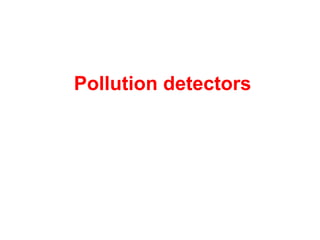Report
Share

Recommended
Recommended
More Related Content
What's hot
What's hot (20)
Pond preparation and biosecurity for shrimp culture

Pond preparation and biosecurity for shrimp culture
04 control of spills and mechanism of implementation of biosafety guidelines

04 control of spills and mechanism of implementation of biosafety guidelines
Radioactive waste and their impact on aquatic organisms

Radioactive waste and their impact on aquatic organisms
Similar to B1.4 pollution detectors
Similar to B1.4 pollution detectors (20)
Insects As Bioindictors for Different Levels of Pollution

Insects As Bioindictors for Different Levels of Pollution
Ecological indicators and support with local examples

Ecological indicators and support with local examples
Insects as bioindicator of environmental pollution

Insects as bioindicator of environmental pollution
Lab 3 – BiodiversityExperiment 1 Effects of Water Pollution o.docx

Lab 3 – BiodiversityExperiment 1 Effects of Water Pollution o.docx
Microbes Ecology, Microflora & Sanitary-indicative bacteria of soil, water & Air

Microbes Ecology, Microflora & Sanitary-indicative bacteria of soil, water & Air
More from Steve Bishop
More from Steve Bishop (20)
B1.4 pollution detectors
- 3. Lichen
- 4. Usefulness of lichens as bio-indicators • They are found almost everywhere and at all seasons • They absorb nutrients and pollutants from the air, often to high concentrations • Different species show different sensitivities and accumulation abilities • They are symbiotic organisms. The fungus cannot survive if the algae is killed by pollution
- 10. Indicator species Pollution Level Mayfly nymph Clean Caddis fly larva Low Water louse High Sludgeworm Very high
- 11. (a) What can you conclude from the results about the level of pollution in the stream? Give your reasons. [3 marks] The level of pollution is decreasing / the stream has become cleaner. [1] The species that live in cleaner water have increased or specific examples. [1] The species that live in polluted water have decreased or specific examples.[1]
- 12. (b) Nona said that these samples should be taken at the same time each year but Rhys said it doesn’t matter. State who you think is right, giving a reason. [1 mark] (c) State one other non-biological factor that could be measured and used as an indicator of the level of pollution in the stream. [1 mark] (b) (Nona because) water conditions such as temperature must be the same to be a valid comparison. [1] (c) Oxygen/pH/heavy metals/nitrate/phosphate/pesticide (Any 1) [1]